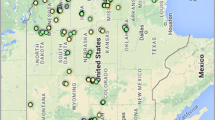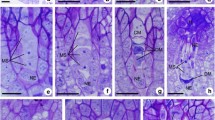Abstract
St. John's wort (Hypericum perforatumL.) is a medicinal crop plant that reproduces by apomixis. To study the reproductive diversity within the initial breeding material, 656 plants from 92 accessions of the species were analysed by flow cytometric seed screening (FCSS) and compared to 66 plants of cv. ‘Topaz’ as a control. Among plants from the 92 accessions, 16 were obligate sexuals, nine were obligate apomicts and all remaining ones were facultative apomicts. Among controls, there were six obligate and 60 facultative apomicts. Tests of reproductive pathways indicated that, in the investigated collection, all apomictic plants were tetraploid and all sexual plants were diploid. A strategy for a cross breeding program in St. John's wort is illustrated by crossing one diploid obligately sexual mother plant with six tetraploid facultative apomicts. All 91 F1 progeny obtained were triploid with 58% being obligate sexuals and 42% facultative apomicts. To quantify the different routes of seed formation within facultatively apomictic individuals, the reproductive pathways were reconstructed from about 30 single seeds from each of five tetraploid and two triploid plants using FCSS. The frequency of seed formed by apomixis ranged from 54% to 67% among four tetraploid genotypes. One triploid and two tetraploids formed 23% to 73% of the so-called BIII hybrids (fertilization of unreduced eggs) and one triploid was obligately sexual. The results show that while the mode of reproduction in H. perforatum is highly variable, tetraploid obligate apomicts as well as diploid and triploid obligate sexuals can be selected as starting material for breeding purposes.
Similar content being viewed by others
References
Anonymous: Hypericum, Hyperici herba, 2000. In: European Pharmacopoeia, Council of Europe. Back Issue 2000. Deutscher Apotheker Verlag, Stuttgart, 2000, p. 1438.
Arnholdt-Schmitt, B., 2000. RAPD analysis: a method to investigate aspects of the reproductive biology of Hypericum perforatum L. Theor Appl Genet 100: 906-911.
Čellárová, E., K. Kimáková & R. Brutovská, 1992. Multiple shoot formation and phenotypic changes of R0 regenerates in Hypericum perforatum L. Acta Biotechnol 12: 445-452.
Čellárová, E., R. Brutovská, Z. Daxnerová, K. Brunáková & R.C. Weigel, 1997. Correlation between hypericin content and the ploidy of somaclones of Hypericum perforatum L. Acta Biotechnol 17: 83-90.
Chatterjee, S.S., M. Nöldner, E. Koch & C. Erdelmeier, 1998. Antidepressant activity of Hypericum perforatum and hyperforin: the neglected possibility. Pharmacopsychiatry 31: 7-15.
Gaudin, M., X. Simonnet, N. Debrunner & A. Ryser, 2000. Breeding for high-yielding, dieback tolerant variety of Hypericum perforatum L. Proceedings of 2nd Int Symp of Breeding Research on Medicinal and Aromatic Plants, July 11th-15th 2000, Chania, Greece, PA9.
Halušková, J. & E. Čellárová, 1997. RFLP analysis of Hypericum perforatum L. somaclones and their progenies. Euphytica 95: 229-235.
Mártonfi, P., M. Repčák & L. Mihoková, 1996. Hypericum maculatum Crantz subsp. maculatum × H. perforatum L. (Hypericaceae): Corroboration of natural hybridization by secondary metabolite analysis. Folia Geobot Phytotax 31: 245-250.
Matzk, F., 1991. New efforts to overcome apomixis in Poa pratensis L. Euphytica 55: 65-72.
Matzk, F., A. Meister & I. Schubert, 2000. An efficient screen for reproductive pathways using mature seeds of monocots and dicots. Plant J 21: 97-108.
Matzk, F., A. Meister, R. Brutovská & I. Schubert, 2001. Reconstruction of reproductive diversity in Hypericum perforatum L. opens novel strategies to manage apomixis. Plant J 26: 275-282.
Matzk, F., K. Hammer & I. Schubert, 2003. Coevolution of apomixis and genome size within the genus Hypericum. Sex Plant Reprod: in press.
Myers, O., 1963. Studies of reproduction and hybridization in five species of Hypericum native to Eastern North America. Ph.D. Thesis, Cornell Univ. (Diss Abstr Botany 24: 3515-3516).
Murch, S.J., K.L. Choffe, J.M.R. Victor, T.Y. Slimmon, S. Krishna Raj & P.K. Saxena, 2000. Thidiazuron-induced plant regener84 ation from hypocotyl cultures of St. John's Wort (Hypericum perforatum cv. ‘Anthos’). Plant Cell Rep 19: 576-581.
Pank, F. & H. Heine, 2002. Aktueller Stand der Sortenschutzerteilung bei Arznei-und Gewürzpflanzen in Deutschland und in der EU (Current status of plant breeders rights of medicinal and aromatic plants in Germany and in the EU). Zeitschrift für Arznei-und Gewürzpflanzen (J Medicinal and Spice Plants) 7: 310-314.
Pretto, F.R. & E.R. Santarem, 2000. Callus formation and plant regeneration from Hypericum perforatum leaves. Plant Cell, Tissue and Organ Culture 62: 107-113.
Robson, N.K.B., 1981. Studies in the genus Hypericum L. (Guttiferae) 2. Characters of the genus. Bulletin British Museum (Natural History) Botany Series 8: 58-226.
Schenk, R., C. May, R. Franke & U. Bauermann, 1999. Morphologische und inhaltsstoffliche Variabilität und Ertrag bei Hypericum. Tagungsband: Fachtagung ‘Arznei-und Gewürzpflanzen’, 01.-02.10.1998, Gießen, pp. 240-245.
Scholze, P., F. Pank, E. Foltys de Garcia, W.D. Blüthner, M. Dehe & E. Schneider, 2001. Bewertung der Anfälligkeit von Johanniskraut (Hypericum perforatum L.) gegenüber der Johanniskrautwelke (Colletotrichum cf. gloeosporioides). (Valuation of the susceptibility of St. John's-wort (Hypericum perforatum L.) to the wilt disease caused by Colletotrichum cf. gloeosporioides). Zeitschrift für Arznei-und Gewürzpflanzen (J Medicinal and Spice Plants) 6: 209-214.
Schulte, J., B. Büter, W. Schaffner & K. Berger, 1996. Gametic embryogenesis in Hypericum ssp. In: F. Pank (Ed.), Beiträge zur Züchtungsforschung, Bundesanstalt für Züchtungsforschung an Kulturpflanzen, Proc Int Symp: Breeding Research on Medicinal and Aromatic Plants, Quedlinburg, Germany, 30.06.-04.07.1996, pp. 307-310.
Schulte, J., W. Schaffner, B. Büter & K. Berger Büter, 1999: Kreuzungsexperimente mit verschiedenen Arten der Gattung Hypericum. (Study on the crossability of different species of the genus Hypericum: Optimization of the crossing method and interspecific hybridization). Zeitschrift für Arznei-und Gewürzp-flanzen (J Medicinal and Spice Plants) 4: 126-133.
Steck, N., M. Messmer, W. Schaffner & K. Berger-Büter, 2001. Molecular markers as a tool to verify sexual and apomictic offspring of intraspecific crosses in Hypericum perforatum. Planta Medica 67: 384-385.
Author information
Authors and Affiliations
Rights and permissions
About this article
Cite this article
Pank, F., Matzk, F., Kästner, U. et al. Reproductive diversity and strategies for breeding in St. John's wort (Hypericum perforatum L.). Euphytica 134, 77–84 (2003). https://doi.org/10.1023/A:1026115508883
Issue Date:
DOI: https://doi.org/10.1023/A:1026115508883




